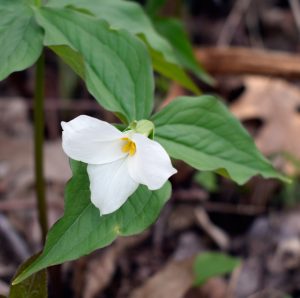White Trillium
 Trillium grandiflorum, also known as large-flowered trillium, carpets the forest floor May into June with 3 white petals that slowly turn pinkish as the flower matures. Acting as leaves, three smooth-edged floral bracts present in a single whorl of 3 at the top of the stem. From there the flower stalk rises up 2 to 3 inches to form a single, 3-petaled flower with 3 sepals spreading open with the unfolding bloom. Deep veins radiate from the base of each floral bract which is up to 6″ long from the base to pointed tip. Trillium is a native plant to Minnesota, favoring habitats of rich soil in shade to part shade. They spread by rhizomes slowly over time and also by seeds.
Trillium grandiflorum, also known as large-flowered trillium, carpets the forest floor May into June with 3 white petals that slowly turn pinkish as the flower matures. Acting as leaves, three smooth-edged floral bracts present in a single whorl of 3 at the top of the stem. From there the flower stalk rises up 2 to 3 inches to form a single, 3-petaled flower with 3 sepals spreading open with the unfolding bloom. Deep veins radiate from the base of each floral bract which is up to 6″ long from the base to pointed tip. Trillium is a native plant to Minnesota, favoring habitats of rich soil in shade to part shade. They spread by rhizomes slowly over time and also by seeds.
Trillium flowers are very long lived, and are also very slow growing. Five years or so will pass after seed germination before a trillium begins to produce its first flower. Like wild ginger, trillium seeds are spread by ants who are attracted to the fatty structure attached to the seed. This structure is called an ‘elaiosome’ in botany. Ants drag the seeds back to their nests, consume the yummy elaiosome treat, and leave the seeds behind to germinate. The Eloise Butler Friends of the Wildflower site informs us that picking the flower will stop the plant from blooming for several years, so please leave these very delicate plants free to grow and flower as they will. Each trillium flower seems like a gift that has taken so long to unwrap — sort of like baby turtles making their way once they are born to the safety of the water. Go trilliums!
For many people, trillium is an iconic sight of spring. When driving along the highway, we look annually for the ‘trillions’ of trilliums daintily shining out in bright profusion as they spread far and wide across the forest floor in the dappled sunshine. Our gazes readily sink into this sight for a reward of pure enjoyment.
